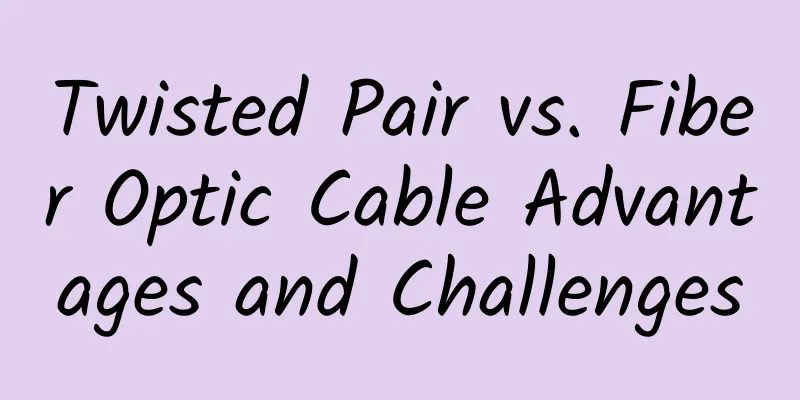What exactly are the CE, C++, and C+L bands?

|
This article is reprinted from the WeChat public account "Xianzao Classroom", the author is Xiaozaojun. Please contact the WeChat public account of Xianzao Classroom to reprint this article. When I wrote the article on optical communications a few days ago, I mentioned the CE, C++, and C+L bands. Many students asked, "We only knew about O-band, E-band, C-band, and L-band before, but never heard of CE, C++, and C+L bands. What do these mean?" Today, Xiaozaojun will explain it to you all. Traditional bandAs we all know, fiber optic communication uses light as an information carrier to transmit information in the fiber core for communication. However, not all light is suitable for optical fiber communication. Different wavelengths of light have different transmission losses in optical fibers. The core of optical fiber - fiber core (quartz fiber) In order to minimize losses and ensure transmission efficiency, researchers have been working hard to find light with the most suitable frequency (wavelength). In the early 1970s, optical fiber communication began to be put into practical use. At that time, the main research and development object was multimode optical fiber. Multimode fiber has a larger core diameter, allowing different modes of light to be transmitted on a single fiber. The earliest light used was the light with a wavelength of 850nm. This band is also directly called the 850nm band. Later, in the late 1970s and early 1980s, single-mode optical fiber began to be used on a large scale. After testing, engineers found that light in the wavelength range of 1260nm to 1360nm has the least signal distortion and the lowest loss caused by dispersion. Therefore, they adopted this wavelength range as the early optical communication band and named it O-band. O means "Original". After thirty or forty years, after a long period of exploration and practice, experts gradually concluded that there is a "low-loss wavelength region", that is, the 1260nm~1625nm region. Light in this wavelength region is most suitable for transmission in optical fibers. This area is further divided into five bands: O-band, E-band, S-band, C-band and L-band. As technology continues to evolve, experts have also verified the law between optical fiber transmission loss and light wavelength, as shown in the following figure: The most commonly used band is called the C band (1530nm~1565nm). C stands for "conventional". The C-band has the lowest loss and is widely used in metropolitan area networks, long-distance, ultra-long-distance and submarine optical cable systems. The C-band is also often used in WDM systems. The L-band (1565nm~1625nm) next to the C-band is the second lowest loss band and one of the mainstream choices in the industry. When the C-band is not enough to meet the bandwidth requirements, the L-band will be used as a supplement. L stands for "long-wavelength". The S-band (1460nm~1530nm), also known as the "short-wavelength" band, has higher fiber loss than the O-band. It is often used as the downstream wavelength of the PON (passive optical network) system. PON is the system for home fiber-optic broadband. Its upstream wavelength is 1310nm and its downstream wavelength is 1490nm. Finally, let’s take a look at the E band. This band is a little special, it is the least common band of the five bands. E stands for "extended". When you observe the wavelength and loss relationship graph, you will find that there is an obvious irregular bulge in the E band. That is because in the 1370-1410nm band, the hydroxide ion (OH-) absorbs, so the loss increases sharply. This is also called the water peak. In the early days, due to process limitations, water (OH-based) impurities often remained in the optical fiber glass, resulting in the highest attenuation in the E band and inability to use normally. Later, the dehydration technology in the glass manufacturing process was invented, and the attenuation of the most commonly used optical fiber in the E band (ITU-T G.652.D) became lower than that in the O band, thus solving the water peak problem. (G.652.D is also called low water peak fiber or water peak-free fiber.) In addition to the above bands, there is actually another band that will be used, that is the U band (ultra-long-wavelength band, ultra-long band: 1625-1675 nm). The U band is mainly used for network monitoring. To summarize, the following table shows: Band expansion trendToday, the situation in the band has changed again. As network data traffic continues to grow, the capacity of optical fiber needs to be further expanded. There are several ways to increase capacity: 1. Use more powerful modulation methods, spectrum shaping technology, and various multiplexing methods (polarization multiplexing, space division multiplexing, and even angular momentum multiplexing, etc.); 2. Increase the number of cores in a single optical fiber; 3. Use a larger spectrum bandwidth and increase the number of channels. For the third method, experts came up with the idea of expanding the existing bands (those mentioned above). CE Band The traditional C band refers to the band from 1529.16nm to 1560.61nm, which is 195.9THz to 191.6THz in frequency, and the usable spectrum range is about 4THz. At 50GHz interval, this traditional C band can support 80 waves, so it is also called C80 band. The CE band is based on the C80 band and is slightly extended to longer wavelengths. The wavelength range is 1529.16-1567.14nm, and the usable spectrum range is approximately 4.8THz. At 50GHz intervals, the CE band can support 96 wavelengths, so it is also called the C96 band. Compared with the C80 band, the transmission capacity of the C96 band can be increased by 20%. C++ Band Let's take a look at the C++ band scheme. Everyone will feel familiar when seeing C++. But in fact, the C++ here has nothing to do with the C++ programming language. C++ is actually a further extension of C96, with a wavelength range of 1524-1572nm, an approximate usable range of 6THz, and the number of wavelengths can be extended to 120. C++ is therefore also called the C120 band (also known as the Super C Band). Compared with the C80 band, the transmission capacity of the C++ band can be increased by 50%. C+L band Finally, let’s take a look at the C+L band solution. The L band is 1565nm to 1625nm. If calculated based on 1570~1611nm, the available spectrum range is about 4.8THz. Therefore, the C+L band can achieve 192 wavelengths, the spectrum bandwidth is close to 9.6THz, and the transmission capacity is nearly doubled. Draw a picture and compare it as follows: Here is another table for easier comparison: It is worth mentioning that C+L also has multiple potential solutions and spectrum boundaries, such as: C4T+L4T: 1529~1561nm(4THz) + 1572~1606nm(4THz) C6T+L6T: 1524~1572nm(6THz) + 1575~1626nm(6THz) As you may have noticed, the L band also has the L++ band, which is sometimes also called the Super L Band. ConclusionThe above is an introduction to the differences between the C, CE, C++, and C+L bands. In general, the available spectrum resources of optical fiber can be expanded to a very large range. However, it is not so easy to realize it. The main challenge comes from the higher requirements that extended spectrum places on optical devices. Active devices such as erbium-doped fiber amplifiers (EDFA) and optical modulators, and passive devices such as WSS (limited by LCOS technology) cannot directly support the newly expanded spectrum range and need to be upgraded. Especially the L-band, which is worse in terms of transmission performance degradation, will increase the complexity of operation and maintenance, and thus increase cost investment. On the other hand, the specific standards for spectrum expansion plans need to be further improved and clarified. In short, spectrum expansion is an inevitable path, but it will take time to tell us how to take this path. Well, that’s all for today, thank you for your patience in reading! |
<<: The software-defined revolution: making SD-Branch possible
>>: Let’s listen to what 5G R18 is talking about?
Recommend
10 solutions for high-concurrency and high-traffic websites
1. Hardware upgrade An ordinary P4 server can gen...
Europe focuses on 6GHz rules, Wi-Fi -7 is still a long way off
European regulators have been facing increasing p...
As work-from-home increases, so do attacks on VoIP and unified communications
As companies have shifted to a work-from-home mod...
Attention! Eight pitfalls in managing integrated cabling systems
After nearly 20 years of development, the integra...
Hostodo: Las Vegas/Miami NVMe hard drive VPS from $19.99 per year
Hostodo is a foreign VPS hosting company founded ...
Get AlertManager working in 5 minutes and access 10+ notification channels including SMS, voice, etc.
SLS Alarm Management As a member of the Prometheu...
The 5G commercial era is coming, and large-scale commercial use will be achieved in 2020
The Ministry of Industry and Information Technolo...
Comprehensive network monitoring tools to watch in 2020
Network monitoring is one of the most important n...
Fiber pre-entry: A new strategy to accelerate FTTH deployment
With the progress and development of human societ...
Read the history of instant messaging IM in one article
ICQ, the instant messaging software we are more f...
Ranking of JavaScript open source projects in September
[[428048]] The ranking of the most popular JavaSc...
8 essential skills for network engineers in 2017
The current average job responsibilities of a net...
How to build your own CAN-bus application layer protocol
With the decline in the price of CAN-bus related ...
Various abnormal phenomena and analysis from TCP protocol to TCP communication (Part 1)
Many people always think that learning TCP/IP pro...
What is Gigabit Ethernet (GBE)?
The world has been in need of faster data transfe...









